This should be done prior to gluing the Boat deck
and A deck together.
|
Step
2 (fixing the wheelhouse walls).
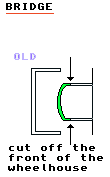 The
interior wheelhouse on the model is that of the early
Olympic, being more forward and rounded. The Titanic's
was flat fronted and shorter so there was a clear view
from one wing cab over to the other. The
interior wheelhouse on the model is that of the early
Olympic, being more forward and rounded. The Titanic's
was flat fronted and shorter so there was a clear view
from one wing cab over to the other.
To
fix the front wall trim back the deckhouse bulkheads (partsH20
A&B) by 5mm so that the face of the wheelhouse will
sit just behind the imaginary line extending between the
bridge wing bulwarks that become the aft side of the wing
cabs (parts G28 A&B).
|
|
Step
3 (removing the molding).
 Now
you will have to trim the raised ridge on the deck that
outlines the profile of the original wheelhouse. Now
you will have to trim the raised ridge on the deck that
outlines the profile of the original wheelhouse.
You
can do one of two things here:
- The first
is to cut and file off this raised curved front to realign
with the new face 5mm back. You can also use the grinding
wheel on a Dremel tool or similar. The idea is to not
hack up the deck so grinding with a precision tool might
be the easiest solution.
- Just leave
it and build over it. Once the bridge is built the interior
tends to be dark enough inside that you can effectively
"cut corners". Painting this platform a wood color and
adding a GMM crew person or two can mask this area enough
to save the trouble of trying to remove it without marring
the deck. We opted for leaving it there and masking
it. The viewer has to make a concentrated effort to
notice it.
|
|
Step
4 (windows).
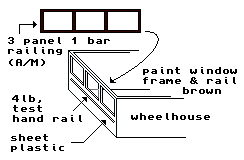 Now
to make the new forward wall of the wheelhhouse. Now
to make the new forward wall of the wheelhhouse.
Trim
off 3 panels from the 1-bar A/M railings and part of the
next panel, leaving the part with four 'tags'.
Add
the new windows once the officer's deckhouse bulkheads
and your trimmed wheelhouse walls are mounted to the boat
deck.
Check
the fit of the railing section and trim the tags as required.
Now apply glue to the 4 tag ends and mount this on the
upper half of the new opening between the walls.
|
|
The wheelhouse
of the Titanic had five windows. To make a five paned
window cut out the posts from the interior panels and
glue them more outboard then trim off two more posts from
a spare panel or pulled sprue to make new "mullions" and
glue these inboard of the posts you just moved.
We just left
the three as it is difficult to see in there, moreso when
you add crew and instruments. Modeler's choice. It will
be important to get the mullions right if you are lighting
the model.
Paint the window
frames dark brown.
|
|
Step
5 (forward wall).
This
now leaves a rectangular opening beneath the windows to
the deck.
To
fill this cut a sheet plastic panel face to the dimensions
of this opening and glue this underneath the windows.
The panel will be approx. 15mm long x 4mm high if you
leave the molding on the deck. 5mm high if you are grinding
it off.
Now
fill the small openings between the gluing tabs and the
bulkheads on either side of the new windows with KRISTAL
KLEAR.
When
dry, paint them flat white to match the deckhouse.
|
|
Step
5 (adding the handrail).
There
was a hand railing just below the windows. To simulate
this glue a length of monofilament fishing line (or pulled
sprue of equal diameter) along the face of the wall about
0.5mm below the windows.
Paint
the monofilament dark brown first, then glue into place
using a CA adhesive.
|
|
 Step
7 (preparing the deck for the instruments). Step
7 (preparing the deck for the instruments).
- Note:
We did not put the front bulkhead of the bridge (part
J39) on until later in construction, this allowed a
maximum amount of space to work on the interior of the
bridge.
First
mark the seven points on the deck where each bridge instrument
will sit.
Now
drill out six of the marks as follows:
From
starboard:
| Mark
1: |
Drilled |
Starboard
reciprocating engine telegraph to engine room. |
| Mark
2: |
Drilled |
Either
emergency back-up telegraph or engine telegraph from
docking bridge. |
| Mark
3: |
Drilled |
Binnacle |
| Mark
4: |
Glued |
Wheel
(NOT drilled, just glued) |
| Mark
5: |
Drilled |
Either
emergency back-up telegraph or engine telegraph from
docking bridge. |
| Mark
6: |
Drilled |
Docking/steering
telegraph to docking bridge. |
| Mark
7: |
Drilled |
Port
reciprocating engine telegraph to engine room. |
|
|
We
did not drill out a hole for the binnacle because it will
be made of thicker plastic stock and sit on the deck with
a more stability than the thinner based instruments around
it.
Thanks to Mark
Darrah, Bill Sauder & Bob Read for their continued
investigations into the layout of the Bridge insturments.
|
|
Step
8 (making the instrument bases).
To
make the bases for the instruments slip microrod up through
the holes until they stand 3mm above the deck. These will
support the various telegraphs and the ship's wheel.
Now
tack them in place with a bead of glue on the bottom side.
This makes them more secure for working on in the following
steps.
|
|
Step
9 (making the telegraph instruments).
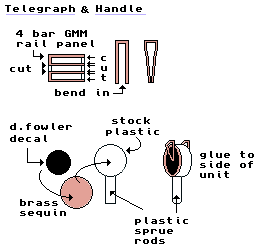 To make the telegraphs cut the 2mm diameter pulled sprue
or plastic rod into 6 x 1mm wide discs. To make the telegraphs cut the 2mm diameter pulled sprue
or plastic rod into 6 x 1mm wide discs.
For
ease, work from the center out. Glue the center bottom
of the disk to the center top of the poles in the following
orientation:
From
starboard:
1st
Hole = Engine telegraph (port/starboard)
2nd Hole = Docking telegraph (port/starboard)
3rd Hole =Steering telegraph (bow/stern)
4th spot = Binnacle/Wheel (just glued)
5th Hole = Turbine telegraph (port/starboard)
6th Hole = Docking telegraph (port/starboard)
7th Hole = Engine telegraph (port/starboard)
|
|
Step
10 (adding the telegraph brass trim).
Make
the brass trim from 12 gold/brass sequins. The sequins
will be too big for the job so trim them off the outer
edges to a diameter of 2.5mm or slightly larger than the
2mm disks you cut in step 8.
Add
a drop of CA glue to either face a telegraph unit and
place a sequin flush to each side. Repeat for each telegraph.
Now
add one of Duane Fowler's Titanic telegraph decals to
each sequin . If you are not using Duane's decals then
paint the center of the sequin area black just leaving
the outer edge the original gold color
Paint
the sprue circle between the sequins and the pole it sits
on flat white.
|
|
Step 11
(adding the telegraph handles).
To make the
telegraph's handles cut off one 4 bar panel of spare GMM
or Tom's Modelworks railings. Cut off the upright post
between rails 2 & 3. This should result in two small
rectangles. See diagram in step 8.
Trim the post
ends off of one end of each rectangle to create a 'U'
shaped piece.
Now bend the
open end of the rails in towards each other, the result
should look like a small brass triangle. Glue the point
of the triangle to the center of the decal/sequin combo
on the telegraph face and leave the other end sticking
just slightly up and over the rim of the sequin.
Repeat for
the other side of the telegraph and the rest of the other
telegraphs.
|
|
Step
12 (making the binnacle).
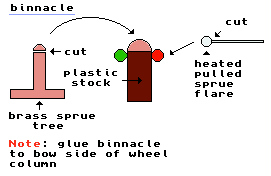 This
was constructed from two pieces. This
was constructed from two pieces.
First cut a piece of plastic stock 2mm wide and 4mm long.
Next
remove some of the parts from the model's brass tree (A
1-10) now trim the tip off of one of the part holders
so it looks like a half of a sphere. Glue this to the
top of the 4mm plastic stock. You can elect to make this
structure out of a single piece of plastic stock and paint
the top of the binnacle brass. Modeler's choice.
 Glue
a microdot on either side of the brass half sphere at
its base. See opposite. Glue
a microdot on either side of the brass half sphere at
its base. See opposite.
Glue
the unit in front of (the bow side) of pole 3.
Paint
the base dark brown and the microdots one green and the
other red. Leave the brass as is.
|
|
Step
13 (making the wheel).
Method
1
Use
ship's one of the two wheels supplied with Tom's Modelworks
misc set.
Method 2
If
you have bought the improved GMM ship's wheel for the
docking bridge the A/M wheel will now be free for this
project. The A/M's wheel not to scale and will not as
noticeable if placed in the bridge area.
Trim
the A/M wheel off the docking bridge instrument `cluster'
and then glue on to pole No 3 aft of the binnacle.
Paint the pole flat white and the wheel a dark brown.
|
|
Step
14 (making the step/platform).
There
was a small step/platform on the deck floor to the center/stern
of the steering telegraph (pole No3).
Cut
a rectangle of ribbed sheet plastic 4mm long x 2mm wide
and glue this into position.
Paint
dark brown.
|
|
Step
15 (making the wheelhouse roof support pillars).
Cut
two 8mm lengths of pulled sprue 0.75mm in diameter and
glue to the bridge deck as seen in the Bridge
diagram above.
Paint dark brown.
|
|
Step
16 (making the chart box).
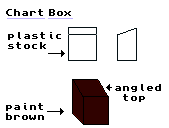 On
the inboard portside of the bridge wall aft of the window
by the walkway opening was a (chart?) box on the wall. On
the inboard portside of the bridge wall aft of the window
by the walkway opening was a (chart?) box on the wall.
Cut
plastic sprue tree stock and sand it square until it is
2.5 high x 2.5mm long x 2mm wide. Then file the top to
a 30 degree angle sloping forward. Glue onto the wall
with the bottom of the box equal to the bottom sill of
the window.
Paint
leather brown.
|
|
Step
17 (making the table).
 Cut
a small rectangle of ribbed sheet plastic 3mm long x 2mm
wide. Cut
a small rectangle of ribbed sheet plastic 3mm long x 2mm
wide.
Next
cut two 2.5mm lengths of 0.75mm diameter pulled sprue.
Flip
the sheet plastic over so the ribs are facing down and
the smooth bottom is facing up and glue one pulled sprue
`leg' to each front corner.
When
dry flip the `table' over and glue to the inboard starboard
wall aft of the window with the legs to the front and
the table's top along the wall.
Paint
leather brown.
|
|
Step
18 (adding the window weather covers).
On
the inside of the Navigation bridge underneath the windows
were protective weather covers for each window. These
can be seen on the Olympic in the photograph on page 106
of Leo Marriott's Titanic.
To
make these cut an Evergreen strip to a length of 24mm
x 1.5mm wide. Hold this up to the outside of the bridge
windows and mark off the window layout with a pencil.
Then paint each marked area brown with white spaces between
them. See Bridge diagram above.
When
dry, use the tip of a toothpick dipped in flat white and
paint a dot in the center of each brown square to simulate
the small storm `porthole'. When dry, glue this strip
to the inside of J39 underneath the windows. These portholes
were used in "...extreme weather conditions and not
compromise breaking the glass from wind, hail, waves,
etc." (Dan Cherry).
Also
add a single cover for each window on the port and starboard
side of the bridge. Either paint directly onto the inside
wall underneath the window or fashion from sheet plastic.
Dan
Cherry offers this alternative method:
"I
painted the entire lower half under the windows flat dark
brown. Once dry, paint thin white lines that continue
from the areas between the windows to the floor. You will
at this point have dark brown squares under the windows.
Paint a white dot in the center of each square. Refer
to page 86 of The Last Days of Titanic to see the exact
pattern".
|